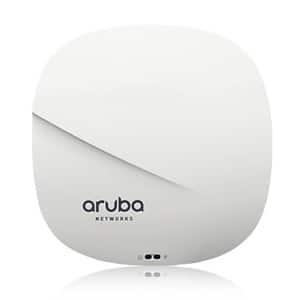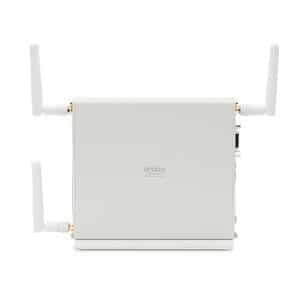Aruba 310 Series
High performance 802.11ac Wave 2
High performance 802.11ac Wave 2. The Aruba 310 Series access points provide the fastest gigabit data speeds and superb user experience for mobile devices, Internet of Things (IoT) devices, and applications in dense office environments.
These Wave 2 access points deliver multi-user MIMO (MU-MIMO) aware ClientMatch to boost network efficiency and support the growing device density demands on your network.
These APs have an integrated BLE Beacon to remotely manage battery-powered Aruba Beacons. Also for improved network simplicity and security, Dynamic Segmentation automatically enforces real-time device-level access policies on Aruba wired and wireless networks.
✓ Competitive Pricing
✓ Worldwide express shipping
✓ Unmatched customer support

Boost network efficiency
With multi-user MIMO (MU-MIMO), you can transmit to multiple Wave 2 clients from an AP, at the same time.
ClientMatch unleashes MU-MIMO
Aruba ClientMatch software groups Wave 2 clients together, enabling MU-MIMO. That means a faster, more efficient network.
Integrated Bluetooth Beacon
310 series APs have an integrated BLE Beacon to simplify management of a large-scale network of battery-powered Aruba Beacons.
UNIQUE BENEFITS
- Aruba 310 Series APs offer a choice of operating modes to meet your unique management and deployment requirements.
- Controller-managed mode – When managed by Aruba Mobility Controllers, Aruba 310 Series APs offer centralized configuration, data encryption, policy enforcement and network services, as well as distributed and centralized traffic forwarding.
- Aruba Instant mode – In Aruba Instant mode, a single AP automatically distributes the network configuration to other Instant APs in the WLAN. Simply power-up one Instant AP, configure it over the air, and plug in the other APs – the entire process takes about five minutes. If WLAN requirements change, a built-in migration path allows 310 Series instant APs to become part of a WLAN that is managed by a Mobility Controller.
- Remote AP (RAP) for branch deployments
- Air monitor (AM) for wireless IDS, rogue detection and containment
- Spectrum analyzer, dedicated or hybrid, for identifying sources of RF interference
- Secure enterprise mesh
- For large installations across multiple sites, the Aruba Activate service significantly reduces deployment time by automating device provisioning, firmware upgrades, and inventory management. With Aruba Activate, Instant APs are factory-shipped to any site and configure themselves when powered up.
SPECIFICATIONS
- AP-314 (controller-managed) and IAP-314 (Instant):
- 802.11ac – 5GHz 4×4 MIMO (1,733Mbps max rate) and 2.4GHz 2×2 MIMO (300Mbps max rate) radios, with a total of four dual-band RP-SMA connectors for external antennas
- AP-315 (controller-managed) and IAP-315 (Instant):
- 802.11ac – 5GHz 4×4 MIMO (1,733Mbps max rate) and 2.4GHz 2×2 MIMO (300Mbps max rate) radios, with a total of four integrated omni-directional downtilt dual-band antennas
WI-FI RADIO SPECIFICATIONS
- AP type: Indoor, dual radio, 5GHz 802.11ac 4×4 MIMO and 2.4GHz 802.11n 2×2 MIMO
- Software-configurable dual radio supports 5GHz (Radio 0) and 2.4GHz (Radio 1)
- 5GHz: Four spatial stream Single User (SU) MIMO for up to 1,733Mbps wireless data rate to individual 4×4 VHT80 or 2×2 VHT160 client devices
- 2.4GHz: Two spatial stream Single User (SU) MIMO for up to 300 Mbps wireless data rate to individual 2×2 VHT40 client devices (300Mbps for HT40 802.11n client devices)
- 5GHz: Four spatial stream Multi User (MU) MIMO for up to 1,733 Mbps wireless data rate to up to three MU-MIMO capable client devices simultaneously
- Support for up to 256 associated client devices per radio, and up to 16 BSSIDs per radio
- Supported frequency bands (country-specific restrictions apply):
- 2.400 to 2.4835GHz
- 5.150 to 5.250GHz
- 5.250 to 5.350GHz
- 5.470 to 5.725GHz
- 5.725 to 5.850GHz
- Available channels: Dependent on configured regulatory domain
- Dynamic frequency selection (DFS) optimizes the use of available RF spectrum
- Supported radio technologies:
- 802.11b: Direct-sequence spread-spectrum (DSSS)
- 802.11a/g/n/ac: Orthogonal frequency-division multiplexing (OFDM)
- Supported modulation types:
- 802.11b: BPSK, QPSK, CCK
- 802.11a/g/n/ac: BPSK, QPSK, 16-QAM, 64-QAM, 256-QAM
- Transmit power: Configurable in increments of 0.5 dBm
- Maximum (conducted) transmit power (limited by local regulatory requirements):
- 2.4GHz band: +18 dBm per chain, +21dBm aggregate (2×2)
- 5GHz band: +18 dBm per chain, +24dBm aggregate (4×4)
- Note: conducted transmit power levels exclude antenna gain. For total (EIRP) transmit power, add antenna gain
- Advanced Cellular Coexistence (ACC) minimizes interference from cellular networks
- Maximum ratio combining (MRC) for improved receiver performance
- Cyclic delay/shift diversity (CDD/CSD) for improved downlink RF performance
- Short guard interval for 20MHz, 40MHz, 80MHz and 160MHz channels
- Space-time block coding (STBC) for increased range and improved reception
- Low-density parity check (LDPC) for high-efficiency error correction and increased throughput
- Transmit beam-forming (TxBF) for increased signal reliability and range
- Supported data rates (Mbps):
- 802.11b: 1, 2, 5.5, 11
- 802.11a/g: 6, 9, 12, 18, 24, 36, 48, 54
- 802.11n (2.4GHz): 6.5 to 300 (MCS0 to MCS15)
- 802.11n (5GHz): 6.5 to 600 (MCS0 to MCS31)
- 802.11ac: 6.5 to 1,733 (MCS0 to MCS9, NSS = 1 to 4 for VHT20/40/80, NSS = 1 to 2 for VHT160)
- 802.11n high-throughput (HT) support: HT 20/40
- 802.11ac very high throughput (VHT) support: VHT 20/40/80/160
- 802.11n/ac packet aggregation: A-MPDU, A-MSDU
WI-FI ANTENNAS
- AP-314/IAP-314: Four RP-SMA connectors for external dual band antennas. Worst-case internal loss between radio interface and external antenna connectors (due to diplexing circuitry): 0.6dB in 2.4GHz and 1.2dB in 5GHz.
- AP-315/IAP-315: Four integrated dual-band downtilt omni-directional antennas for 4×4 MIMO with maximum antenna gain of 3.6dBi in 2.4GHz and 6.0dBi in 5GHz. Built-in antennas are optimized for horizontal ceiling mounted orientation of the AP. The downtilt angle for maximum gain is roughly 30 degrees.
- The maximum gain of the combined (summed) antenna patterns for all elements operating in the same band is 3.1dBi in 2.4GHz and 3.8dBi in 5GHz.
OTHER INTERFACES
- One 10/100/1000BASE-T Ethernet network interface (RJ-45)
- Auto-sensing link speed and MDI/MDX
- 802.3az Energy Efficient Ethernet (EEE)
- USB 2.0 host interface (Type A connector)
- Bluetooth Low Energy (BLE) radio
- Up to 4dBm transmit power (class 2) and -91dBm receive sensitivity
- Integrated antenna with roughly 30 degrees downtilt and peak gain of 3.4dBi (AP-314/IAP-314) or 1.5dBi (AP-315/IAP-315)
- Visual indicators (multi-color LEDs): for System and Radio status
- Reset button: factory reset (during device power up)
- Serial console interface (proprietary; optional adapter cable available)
- Kensington security slot
POWER SOURCES AND CONSUMPTION
- The AP supports direct DC power and Power over Ethernet (POE)
- When both power sources are available, DC power takes priority over POE
- Power sources are sold separately
- Direct DC source: 12Vdc nominal, +/- 5%
- Interface accepts 2.1/5.5-mm center-positive circular plug with 9.5-mm length
- Power over Ethernet (POE): 48 Vdc (nominal) 802.3af/802.3at compliant source
- Unrestricted functionality with 802.3at POE
- When using IPM, the AP may enter power-save mode with reduced functionality when powered by an 802.3af POE source (see details on Intelligent Power Monitoring elsewhere in this datasheet)
- Without IPM, the USB port is disabled and transmit power of the 2.4GHz radio chains is reduced by 3dB to 15dBm max when the AP is powered by and 802.3af POE source
- Maximum (worst-case) power consumption: 14.4W (802.3at POE), 13.6W (802.3af POE) or 12.7W (DC)
- Excludes power consumed by external USB device (and internal overhead); this could add up to 6.3W (POE) or 5.9W (DC) for a 5W/1A USB device
- Maximum (worst-case) power consumption in idle mode: 6.4W (POE) or 5.9W (DC)
MOUNTING
- The AP ships with two (white) mounting clips to attach to a 9/16-inch or 15/16-inch flat T-bar drop-tile ceiling.
- Several optional mount kits are available to attach the AP to a variety of surfaces; see the Ordering Information section below for details
MECHANICAL
- Dimensions/weight (unit, excluding mount accessories):
- 182mm(W) x 180mm(D) x 48mm (H)
- 650g/23oz
- Dimensions/weight (shipping):
- 223mm(W) x 218mm(D) x 55mm(H) (W x D x H)
- 850g/30oz
ENVIRONMENTAL
- Operating:
- Temperature: 0° C to +50° C (+32° F to +122° F)
- Humidity: 5% to 93% non-condensing
- Storage and transportation:
- Temperature: -40° C to +70° C (-40° F to +158° F)
REGULATORY
- FCC/Industry of Canada
- CE Marked
- R&TTE Directive 1995/5/EC
- Low Voltage Directive 72/23/EEC
- EN 300 328
- EN 301 489
- EN 301 893
- UL/IEC/EN 60950
- EN 60601-1-1 and EN 60601-1-2
For more country-specific regulatory information and approvals, please see your Aruba representative.
RELIABILITY
MTBF: 916,373hrs (105yrs) at +25C operating temperature
REGULATORY MODEL NUMBERS
- AP-314 and IAP-314: APIN0314
- AP-315 and IAP-315: APIN0315
CERTIFICATIONS
- CB Scheme Safety, cTUVus
- UL2043 plenum rating
- Wi-Fi Alliance (WFA) certified 802.11a/b/g/n/ac
- Passpoint® (Release 2) with ArubaOS and Instant 8.3+
MINIMUM SOFTWARE VERSIONS
- ArubaOS 6.5.0.0
- Aruba InstantOS 4.3.0.0
Related products
-

7200 Series Mobility Controllers
Read more -

User Experience Insight Sensors
Read more -

2540 Series
Read more -

2530 Series
Read more -

Aruba 500H Series Hospitality Access Points
Read more -

Aruba 501 Wireless Client Bridge
Read more -

Aruba 570 Series Outdoor Access Points
Read more -

Aruba 550 Series
Read more

